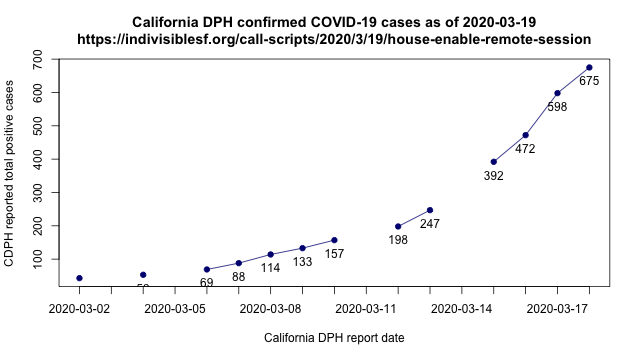Tell Speaker Pelosi: Enable the House to work remotely!
Speaker Nancy Pelosi
SF Office: (415) 556-4862
DC Office: (202) 225-4965
Call the SF office first, but try the DC office if you can’t get through. If you get voicemail, hang up and try a few more times to talk to a real person. Don’t give up! Short direct messages are most effective. Hate the phone? Resistbot is your friend.
Call script:
Hi, my name is ____ and my ZIP code is _____[, and I'm a member of Indivisible SF]. I'm asking the Speaker, in cooperation with the Majority Leader, to amend House Rules to enact rules similar to those proposed by Reps. Swalwell (D-CA) and Crawford (R-AR) to permit remote voting by Members and other forms of Congressional work online.
Two Representatives have been diagnosed with COVID-19 already, and the virus spreads fast. Please do this now, before it's too late and the House no longer has a quorum. We need the House to remain functioning.
Thank you.
Background:
The 2019 novel coronavirus named SARS-CoV-2 that causes COVID-19 is rapidly spreading throughout the United States. Undertesting, asymptomatic carriers, and the incubation period of 1–14 days (median 5 days) mean we don't know precisely how many people currently have the virus and are spreading it to others.
What we do know is that at least two Representatives, Rep. Mario Diaz-Balart (R-FL) and Rep. Ben McAdams (D-UT), have fallen ill and tested positive for SARS-CoV-2.
SARS-CoV-2 spreads fast. Absent severe measures like our City’s shelter-in-place order, it spreads exponentially; doubling times vary, but here in California, the CDPH’s number of “positive cases” has been doubling approximately every three days.
source: Data from CDPH; graph by Indivisible SF
So, there are two known cases now; possibly more soon, as Members (and, hopefully, their staffers and other contacts) get tested. If we follow California’s curve, three days turns 2 into 4; a week turns 4 into 8; another week turns 8 into 32; 32 into 128—three weeks from now, a quarter of the House could be showing symptoms. Many of these people may already have the virus, and simply haven’t shown symptoms yet because they’re still incubating it.
The House, like many rule-making and law-making bodies, requires a quorum to conduct business. According to the Office of the Clerk’s FAQ:
A quorum in the House of Representatives is when a majority of the Members are present. When there are no vacancies in the membership, a quorum is 218. When one or more seats are vacant, because of deaths or resignations, the quorum is reduced accordingly. Because of Members' other duties, a quorum often is not present on the House floor. But any Member may insist that a quorum must participate in any vote that takes place in the House. If a Member makes a point of order that a quorum is not present, and the Speaker agrees, a series of bells ring on the House side of the Capitol and in the House office buildings to alert Members to come to the Chamber and record their presence.
There are a few vacancies in the House; currently, it has a net 431 Members, so the quorum is 216. If there aren’t that many Members physically present on the House floor, they can’t conduct business.
The CDC said Tuesday that “all U.S. events of 10+ people should be cancelled or held virtually”. As of Thursday, March 19, the CDC also recommends cancelling any
event likely to have 10 or more people who are at higher risk of serious COVID-19 illness. This includes older adults and people with underlying health problems such as lung or heart disease and diabetes.
There are numerous Representatives in older cohorts who are most likely to die from the disease, including the Speaker herself (she is almost 80, which puts her risk of death between 10% and 18% if she develops COVID-19)—and the disease generally carries up to a 20% risk of severe or critical illness, including hospitalization and supplemental oxygen.
The way to slow the spread of the virus and flatten the curve is to cancel large in-person events and move them online whenever possible. The House must do this to protect the safety of its Members and staff, as well as its ability to continue functioning.
